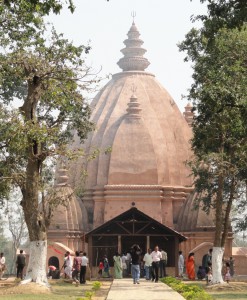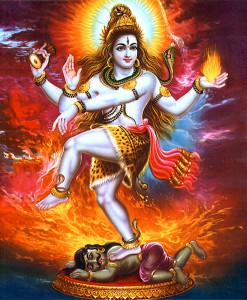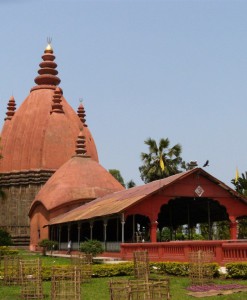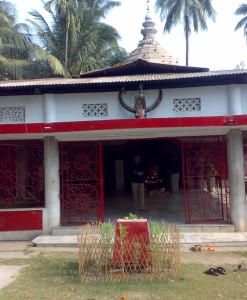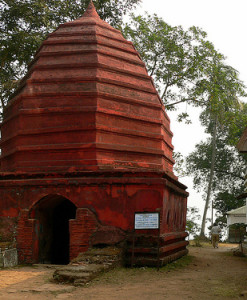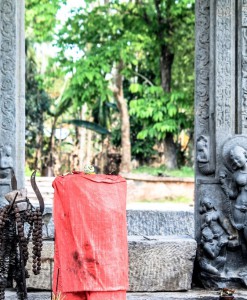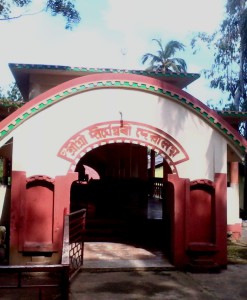No products in the cart.
Situated on the northern banks of the Brahmaputra River, on the foot hills of Chandrabharati hill, the Doul Govinda temple is one of the most important religious spots in Guwahati, Assam. The presiding deity in the temple is Lord Krishna. This temple is one of the most revered shrines of lord Krishna in Guwahati. There is a Namghar (Assamese place of worship) in the temple premise. The Doul Govinda temple is also known to possess immense scenic beauty. Many tourists come to visit the temple and offer their praying to Lord Krishna.
Doul Govinda Temple, Guwahati;
There are many starling sales about this deity and how ‘He’ was brought here by late Ganga Ram Barooa from a deserted place called Sandhyasar near Nalbari. It was to be renamed as Doul Govinda in a different ‘unbelievable’ but true background about , 150 years ago and now a fine temple was erected by raising public donations in 1966.
It is said that one Ganga Ram Barua of Nalbari brought the idol of Lord Krishna from Sandhyasar- a secluded place near Nalbari and installed it in Rajaduar. He used to perform regular “puja” and “archana” in the temple. From that time onwards regular “puja” and “archana” is performed in the Doul Govinda temple and the festival of Holi is celebrated here. The first original structure of the temple was built over a hundred and fifty years ago and it was again renovated in 1966. Presently, the Doul Govinda temple is managed by a committee of 25 members.
The first structure of Doul Govinda Temple was erected more than one hundred and fifty years ago but it was again renovated in 1966. The beckoning landscape opposite the city of Guwahati across the mighty Brahmaputra is UTTAR-GUWAHATI: A semi twonship it is that adores the holy shrine of Lord Doul Govinda at the eastern part historically well-known as Raja-dooar, meaning the kings gate. The den of the city Guwahati flows down the river leaving North Guwahati alone, a place in quiet solitude. The Mandir premises a place of divine bliss are of recent construction started in seventies of the last century with donation, contribution from devotees.
Presently, the project for construction of devotees’ rest house has been taken up near the Mandir premises. The location of the Mandir, the Doul and the two open halls with other adjunct sheds is on a strip of high land cut out and levelled on the northern slope of the Chandra Bharoti hillock. Whereas the main Mandir of the sanctum and the open hail in the front and the Douls to the eastern side are all concrete structures, the second open hall in front of the Douls is of Assam type roof. The Bat-Chora (i.e. the gate) and the entire Mandir premises present a graceful look to any visitor bringing about a serence atmosphere to the locality. The campus is a well-laid-out project of the public of Raja-Dooar in collaboration of other devotees of the neighbouring areas. All these new constructions in place of the old Namghar, Monikut and Doul have come to being with the grace of Lord Doul-Govinda.
By Road: One can easily reach the Doul Govinda Temple by road from any part of Assam. One can also hire a taxi to reach the temple & also auto services are easily accessible.
By Rail: The Temple is well connected through nearest Guwahati Rail Way Station (22.5 km)
to major cities railway stations like Delhi, Agra, Mumbai, Chennai, Ajmer, Pali, Jaipur, Ahmedabad.
By Air: The Temple can be reached through nearest Guwahati Airport (26.6 Km) which is well connected with regular domestic flights to Delhi, Mumbai, Hyderabad, Bangalore, Chennai and other metropolitan cities.
After the end of Ahom rule and post-colonial era, Dirgheswari temple has observed increased Daily worship of Lord Krishna takes place in the Doul Govinda temple. The worship in the temple begins with the opening of the temple at 7 am daily. The idol of lord Krishna is bathed with traditional rituals and practices followed by “archana”. Devotees start coming to the temple after the opening of the temple to offer prayer to the lord. The process continues till the end of the day. The temple doors are closed for a period of time during noon for offering “bhog” to the lord which is followed by distribution of the “bhog” to the devotees in a hall. In the evening “Arati” is done of the lord singing devotional songs.
The Doul Govinda temple is famous for celebrating the festivals of lord Krishna. Different festivals are celebrated in the Doul Govinda temple throughout the year. Among all the festivals celebrated in the temple the festival of colors is the foremost. Holi is celebrated here with much fanfare and gaiety in the temple. The festival of Holi is celebrated for a period of five days in the temple. Local people celebrate Holi in the temple by organizing different programs. During this time of the year thousands of pilgrims gather here in the temple to celebrate the festival of colors. Janamastami is another festival celebrated with equal enthusiasm in the Doul Govinda Mandir like Holi. The celebration of the festival draws a huge number of devotees to the temple. Throughout the night ”puja” and “homjagya” is performed in the temple during Janasmastami. The temple also celebrates the Maghi Purnima festival. During this time “bhog” is prepared and distributed among the devotees.




